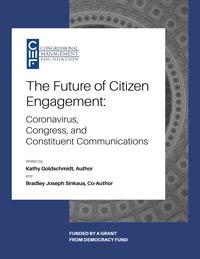 "The Future of Citizen Engagement: Coronavirus, Congress, and Constituent Communications" explores how Members of Congress and their staff engaged with citizens while navigating the constraints posed by COVID-19, and offers examples of how Congress can substantively connect with constituents using modern technology against the backdrop of a global pandemic.
"The Future of Citizen Engagement: Coronavirus, Congress, and Constituent Communications" explores how Members of Congress and their staff engaged with citizens while navigating the constraints posed by COVID-19, and offers examples of how Congress can substantively connect with constituents using modern technology against the backdrop of a global pandemic.
The report addresses the following questions:
- How did congressional offices adapt their communications strategies to meet the immediate needs of their constituents during the onset of COVID-19?
- What techniques did Members use to diversify their constituent outreach?
- What methods of engagement is Congress using now, and likely to use in the future?
The findings are based on a survey of senior congressional staffers, comprising over 120 responses provided to CMF between May 26 and June 19, 2020. Additionally, CMF conducted 13 follow-up interviews with survey respondents who indicated they were willing to speak further about their office operations and constituent communications during COVID-19.
The report was sponsored by a grant from the Democracy Fund.
Key Findings
- Senators, Representatives, and their staffs have become more comfortable using technology. 89% of the respondents agreed or strongly agreed with the statements "My Member/Senator is more open to using technology to engage with constituents than they used to be" and "My staff have developed helpful new skills for interacting with constituents."
- Senators and Representatives are relying on remote interactions with constituents. When asked about the changes in frequency to remote communications during COVID-19, 65% of respondents indicated conducting "significantly more" video conferences with constituents, and 47% responded "significantly more" telephone town hall meetings.
- Congressional offices are having more numerous and more substantive interactions with constituents. Almost two-thirds (63%) of the senior staffers who responded either agreed or strongly agreed with the statement, "My office is receiving more communications from constituents than we did prior to the COVID-19 crisis."
- Congressional offices' approaches to social media and grassroots advocacy campaigns remain unchanged, but personal emails and phone calls are more important. Many offices kept their social media engagement about the same during the COVID-19 crisis, but some significantly increased their use of Facebook. Interviews explained that some offices used Facebook Live for town hall meetings with larger groups ofconstituents, which increased their reliance on Facebook during this time.
- Congressional offices expanded and diversified their constituent outreach and communications strategies. Email newsletters became significantly much more important for communicating the Senator's/Representative's views and activities, with almost half (45%) of the respondents indicating they were significantly more important, and another 41% saying they were more important. Local media became especially valuable, with more than three-quarters (77%) saying it had become more important.
- Offices will likely continue virtual engagement with constituents in the future. Many of the respondents expect their offices to increase the time and resources they devote to remote engagement with individual constituents (77%) and online town hall meetings (60%) in the future. Almost half (46%) expect their offices to increase time and resources on telephone town hall meetings.
- While the immediate transition to remote working was problematic, congressional offices generally felt existing tools allowed them to effectively engage with constituents. Most respondents felt that the usability of virtual meeting resources had some (31%) or a lot (53%) of positive impact on their office's ability to engage effectively with constituents during COVID-19. Additionally, most said technology available to staff had some (36%) or a lot (44%) of positive impact on constituent engagement.


